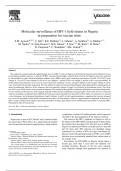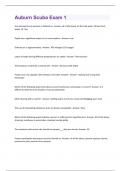Vaccine 20 (2002) 2131–2139
Molecular surveillance of HIV-1 field strains in Nigeria
in preparation for vaccine trials
S.M. Agwalea,b,2,C .Z e hb, K.E. Robbinsb, L. Odamac, A. Saekhoub, A. Edubioc,3,
M. Njokud, N. Sani-Gwarzoe, M.S. Gboune,F .G a of,4, M. Reitza, D. Honea,
D. Pieniazekb, C. Wambebec, M.L. Kalishb,∗
aDivision of Vaccine Research, Institute of Human Virology, Baltimore, MD, USA
bCenters for Disease Control and Prevention, Mailstop G19, 1600 Clifton Road, Atlanta, GA 30333, USA
cNational Institute for Pharmaceutical Research and Development, Abuja, Nigeria
dUniversity of Jos, Jos, Nigeria
eFederal Ministry of Health, Abuja, Nigeria
fUniversity of Alabama at Birmingham, Birmingham, AL, USA
Received 13 July 2001; received in revised form 19 November 2001; accepted 19 December 2001
Abstract
We conducted a national molecular epidemiologic survey of HIV-1 strains in Nigeria to determine the most prevalent subtype(s) for use
in developing candidate vaccines. A total of 230 HIV-1-positive blood samples collected from 34 of the 36 Nigerian states were analyzed
by our modified envgp41-based heteroduplex mobility assay (HMA) and/or gp41 sequencing and analysis. Overall, 103 (44.8%) were
subtype A, 125 (54.3%) were subtype G, one (0.4%) was subtype C, and one (0.4%) was subtype J, and one (0.4%) was unclassifiable. To
further characterize Nigerian viruses to aid in strain selection for candidate vaccines, one gp41 subtype G and five gp41 subtype A strains
were selected for full envelope sequencing. The one subtype G sequence had consistent phylogenies throughout gp160, using programs to
detect recombination. However, all five sequences that were primarily subtype A in gp41 were found to be recombinant viruses. Two of the
five (40%) were A/G/J mosaics with common breakpoints. The remaining three gp160 recombinants all had their own unique break points:
two A/? and one A/?/G, however, all five had the majority of their mosaic breakpoints occurring in gp41. None of the five were consistent
with the circulating recombinant form (CRF)02 AG strain previously reported to be prevalent in West Africa. In conclusion, we showed
a clear dominance and widespread distribution of gp41 subtypes A and G in fairly equal proportions, suggesting that vaccines designed
for use in this geographic locale should incorporate the gene(s) of both subtypes. However, appreciating the magnitude of diversity of
HIV-1 strains in Nigeria may require sequencing and analysis of longer gene regions for the identification of prevalent or emerging CRFs.
Published by Elsevier Science Ltd.
Keywords: HIV-1; Molecular epidemiology; Vaccine; Nigeria
1. Introduction
Nigeria has an area of 923,768 km2and is situated within
the eastern tip of West Africa. It is administratively divided
into 36 states plus the federal capital territory, Abuja, and has
∗Corresponding author.
E-mail address: mkalish@cdc.gov (M.L. Kalish).
1Present Address: National Institute for Pharmaceutical Research and
Development, Abuja, Nigeria.
2Present Address: Robert Koch Institute, Berlin, Germany.
3Present Address: Duke University Medical Center, Durham, NC, USA.
Use of trade names is for identification only and does not constitute
endorsement by the US Department of Health and Human Service, or the
Centers for Disease Control and Prevention.a population of about 120 million people, which represents
one-fifth of the total population of the African continent.
The extent of the HIV-1 epidemic in Nigeria as well as
the impact of the HIV/AIDS control program in that country
has recently been described [1,2]. The first case of AIDS in
Nigeria was reported in 1986 in a sexually active 13-year-old
girl [3]. Soon after, HIV infection was identified among
commercial sex workers (CSWs) in Lagos and Enugu [4].
Because of the widespread patronage of CSWs, cases of HIV
infection were occassionally reported from various parts of
the country [2,5].
Surveillance for HIV/AIDS in Nigeria started about a
decade ago, more than 5 years after the epidemic was
recorded elsewhere. Because of the few cases reported,
many Nigerians thought their population was immune to
0264-410X/02/$ – see front matter. Published by Elsevier Science Ltd.
PII: S0264-410X(02)00059-2 2132 S.M. Agwale et al. / Vaccine 20 (2002) 2131–2139
the virus. However, careful study showed the presence of
AIDS in different parts of the country and an increasing
prevalence from 0.000001% reported in 1986 to 0.22% in
1987 and 3% in 1992 [3]. A national sentinel serosurvey
covering all 36 states of the federation of Nigeria and the
capital city of Abuja has just been concluded, indicating a
prevalence rate in the adult population at 5.4% [6].
A 1994 study conducted in 21 African countries revealed
that subtype A viruses were predominant [7], and the major-
ity of the strains in West Africa have been shown to be the
circulating recombinant form (CRF)02 AG (formally called
IbNG-like) [8], whose genome is primarily subtype A inter-
spersed with smaller fragments of subtype G [8,9]. In Nige-
ria, only subtypes A (including CRF02 AG) and G had been
previously documented [10–14], until recent reports demon-
strated multiple forms of A/G recombinants from small num-
bers of samples [12,15].
While antiretroviral drugs can provide some clinical ben-
efit to HIV-infected persons, the cost and accessibility of
these drugs make their widespread use in Nigeria unlikely.
Despite innovative prevention efforts, a safe and effective
HIV preventive vaccine is urgently needed to bring the
HIV/AIDS epidemic under control. Some of the major
obstacles to the development of an effective vaccine are
the genetic variability of HIV-1 and the selection of ap-
propriate immunogens and delivery systems. Since most
strategies for designing candidate vaccines include the use
of immunogens specific for the predominant subtypes or
CRFs of HIV found within a country or geographic region
(www.iavi.org ), this present study was conducted to deter-
mine the most prevalent subtype(s) of HIV-1 in Nigeria for
inclusion in a vaccine construct.
2. Materials and methods
2.1. Sample collection
HIV-1-positive samples were collected from persons in
34 of the 36 states in Nigeria plus the federal capital ter-
ritory Abuja as part of the recently conducted HIV/AIDS
national surveillance study [6]. This study specifically con-
centrated on HIV-infected and AIDS patients coming to
hospitals for various reasons (blood donors, pre-marital
screening, medical check-ups, and AIDS related illnesses)
in the different states. Unlinked blood samples were col-
lected from HIV-infected patients and then were classified
as symptomatic or asymptomatic by collaborating physi-
cians in the different hospitals. Blood samples were drawn
directly into CPT tubes (Becton and Dickinson, Franklin
Lakes, NJ), sent in cold boxes to the Department of Human
Virology (NIPRD) in Abuja for centrifugation following
manufacturer’s recommendations, and shipped to the Cen-
ters for Disease Control and Prevention (CDC) in Atlanta,
GA, USA, where they were processed and molecularly
analyzed.2.2. DNA extraction and amplification of gp41 and gp160
After separation of plasma and peripheral blood mononu-
clear cells (PBMCs), DNA and/or RNA was purified us-
ing an automated extractor (Organon Teknika, Durham, NJ).
Partial gp41 amplifications were performed as described pre-
viously [12,16]. The entire envelope (gp160) was amplified
by nested polymerase chain reaction (PCR) as previously
described [17] for six selected gp41 subtype A and G strains
with outer primers A and N and with B and M as inner
primers. The amplification reaction was performed with Plat-
inum Taq DNA Polymerase High Fidelity PCR system (Life
Technology, Bethesda, MD) according to the manufacturer’s
instructions. Briefly, the PCR conditions for the first-round
PCR were as follows: a denaturation step of 2 min at 94◦C,
followed by 30 cycles of 15 s at 94◦C, 30 s at 55◦C, and
3.5 min at 72◦C with a final extension for 7 min at 72◦Ci n
a reaction volume of 100 /H9262l. The first-round PCR was pu-
rified with the QIAquick PCR purification kit (Qiagen Inc.,
Valencia, CA) because of the poor quality of the samples
and to eliminate first-round PCR primers. After purification,
30/H9262l was eluted, and 5 /H9262l was used for the nested PCR.
After denaturation for 2 min at 94◦C, a second-round PCR
of 35 cycles was done using the same conditions described
above in a final volume of 100 /H9262l. After nested PCR, the
amplification products were purified, as above, and cloned
into a PCR-XL-TOPO vector (Invitrogen, Carlsbad, CA).
2.3. Heteroduplex mobility assay (HMA)
We used our recently developed gp41-based HMA for
DNA amplification and rapid subtyping of Nigerian iso-
lates [14]. Briefly, 5 /H9262l of second-round PCR product
(approximately 50–100 ng of DNA) was mixed with 5 /H9262l
of subtype-specific reference DNA PCR product (approxi-
mately 50–100 ng) or water and 2 /H9262l of Tris borate EDTA
(TBE) gel buffer (N ovex, San Diego, CA). Heteroduplex
formation occurred after the mixture was heated to 94◦C
for 2 min and then immediately chilled by placing the tubes
on ice. Heteroduplexes and homoduplexes were separated
by electrophoresis on a 6% polyacrylamide gel (1 ×TBE
at 200 V for 1 h) using an 8 cm ×8c m×1 mm XCell II
Mini-cell (N ovex) and were visualized by ethidium-bromide
staining. The unknown sample was scored as being
of the subtype of the reference plasmid with which it
formed heteroduplexes exhibiting the fastest electrophoretic
mobility.
2.4. Sequencing of gp41 and gp160
From the set of 230 strains, 55 gp41-amplified products
were sequenced directly from purified DNA (QIAquick
PCR purification columns, Qiagen Inc.) and six gp160
clones were sequenced by primer walking using the Big
Dye Terminator Cycle Sequencing Ready Reaction Kit (Ap-
plied Biosystems, Foster City, CA) as described previously





